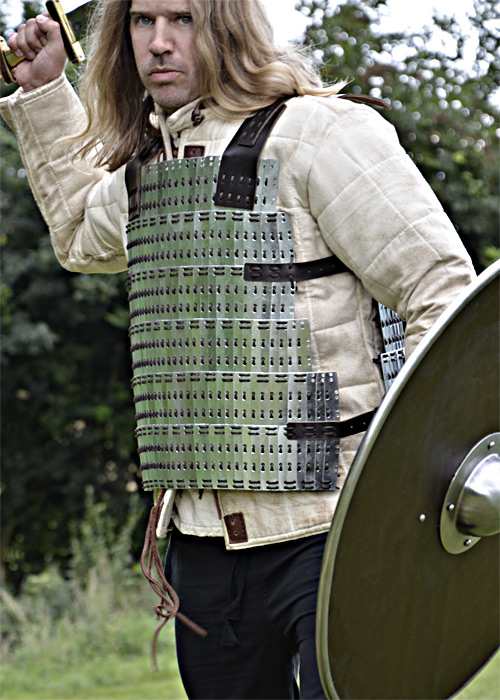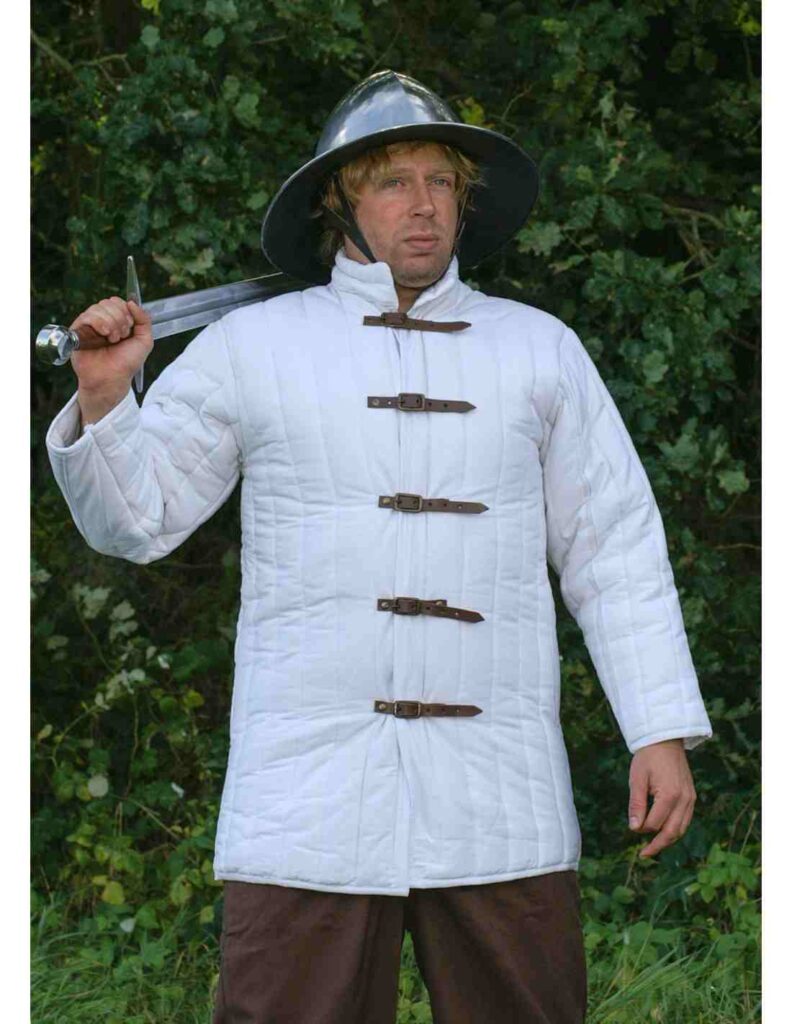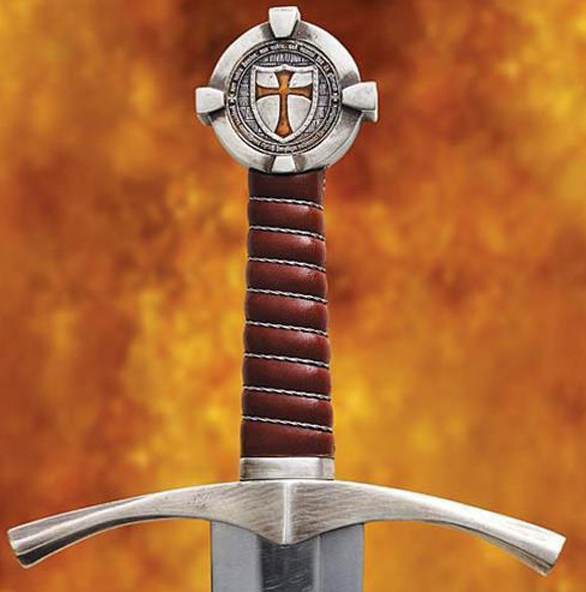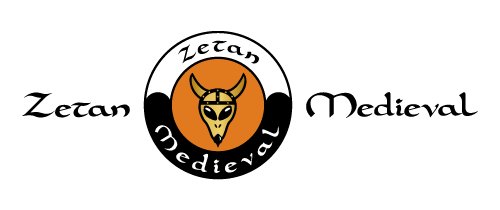CLOTHING AND ARMOR OF THE MEDIEVAL WARRIOR
In the Middle Ages, the warriors wore various garments under the loriga . These were not usually easy to put on, so many gentlemen had an assistant who helped them with the task of dressing, the squire.
Camisoles and leather sayos . – The leather was hardened and was used to defend the chest. As an additional addition, they are reinforced with forearms. They protected the head with a light helmet that was made of metal or leather. This type of armor allowed great mobility, but was very ineffective in hand-to-hand combat, as it was easily torn by swords. They were widely used by archers, because to develop their task they were very practical because they made movement much easier.
Breastplate. – Of Iberian origin. It is triangular in shape and has three discs. They protect the chest, stomach and back. It is a triangulated cuirass composed of three discs that essentially protect both parts of the chest, the breastplate for the front part of the torso and the back for the back, the waist was protected by the skirt . It was attached to the body structure of the warrior by four metal strips. It is a very primary type of armor, as it exposed many particularly sensitive parts of the body, such as the neck, legs, arms, etc. In the 14th century, more elements of protection were added: the purses to protect the upper part of the thigh and were supported together with the breastplate, on the arm various elements could be distinguished, such as the shoulder pads, under them the shoulder straps (they served as also support for spears). Then we can see the codal, for the elbow and the bracer for the forearm. And finally, the mittens or gauntlets for the hands. The knight’s leg was protected by the quixote (for the thigh); the knee pad (for the knee); the greave (for the shin) and the escarpment (for the foot).
Segmented lorica . Of Roman descent. They were a series of horizontal iron or steel bands tied to the torso, completely surrounding it. Other pieces were usually added to safeguard the shoulders. Its light weight made it much easier for the soldier to move. Its most important defects are to expose the arms and legs. Also the spaces between plate and plate allowed the enemy to attack the soldier through these spaces.
Loriga or brunia . From the s. XIII. Formed by metal plates attached to each other by rings, mesh or This is armor made from metal flakes joined together by rings, mesh or strong nails. Its size was variable. The safest were those that, in addition to the upper part of the body, covered the arms and legs. Under the cuirass they wore a padded kilt, which was similar to a shirt that reached to the waist. Although heavier than the previous ones, it still allows great mobility for the soldier who carried it. Its main defect is that they did not protect the armpits and not completely the legs.
Jacerina or chain mail. An evolution of the armor in order to obtain greater protection for the soldier. It is made up of iron or steel rings linked together. The diameter of the rings is small. It also had a leather base with metal discs. It was not an armor that anyone could aspire to, since its cost was considerable. He weighed about 11 . The chain mail was complemented by the coif, a kind of hood intended to protect the head, neck and shoulders, with the brafoneras, which covered the legs and feet. There were two models of brafoneras, the closed ones that covered the entire lower body, and the adjustable ones by means of straps, which allowed the soldier more dynamism. As can be deduced from the description, it was a very difficult armor to cross, in addition to fully protecting the warrior. Its most notable flaws were its cost and its weight .
Plate armor . Also known as full armor, harness, or white armor. They were composed of pieces of steel joined by straps or rivets. They offered comprehensive protection to the knight, both in hand-to-hand combat and with projectiles. They usually wore chain mail underneath. The main advantage of harnesses is to offer more armor than chain mail. But this protective element had many drawbacks: 1 It weighed 40 kilos. 2 Due to the weight, the knight had little mobility and needed help to get on the horse or take off his armor. 3. If he fell off his horse, he was very easy prey for his enemies. 4. They were a very expensive product only available to a few.
Armor for horses. The horse was the essential element of the knight, therefore, armor specially adapted to equines was also designed. At first they were made of leather material, but this was soon replaced by mesh and metals .
Armor maintenance. The armor, the straps and the leather straps were passed through animal fat and allowed to soak in for a couple of hours. They were then cleaned with a dry cloth. The metal armors should not have any contact with water, because if this precaution was not taken they could easily rust. They were cleaned with sand, to then use a dry cloth to remove all signs of moisture. Once this was done, a thin layer of oil was applied to them.

THE CLOTHES OF MEDIEVAL KNIGHTS
The gentleman’s clothing. – A very important part of his clothing, since its absence exposed the knight to burns due to the heating of the armor by solar action. Among his articles of clothing we can mention: the gipoun (short cassock) made up of a shirt and linen underpants, very tight to the body to prevent the skin from rubbing against the armor from causing skin injuries to the knight. Over their clothing they wore the gambeson , which was a linen-based padded garment. They often wore cloaks to protect themselves from the cold or rain. The less affluent only wore a thick cloth tunic called a fustian.
Above the armor, the knight wore the surcoat, it was a long tunic in which the knight’s shield could be distinguished, and this was the only means of distinguishing some knights from others. The surcoats were open at the bottom for purely physiological reasons. Other complementary elements were hats and headdresses. Evidently they also wore around their waists a large belt from which a leather bag usually hung . On the legs they wore a kind of woolen leotard . The shoes were leather. They were closed, gradually imposing the pointed shoe. They also wore underwear such as breeches that were tied at the waist and knees. The material from which they were made was linen. It seems that they were not fitted with a codpiece. This characteristic, so usual in men’s clothing in modern life, is said to have a Turkish origin and its objective was not the usual one of our times, but to be able to rape women without having to lower their pants. Over the breeches, the gentleman put on the breeches , made of fine leather or linen. These leggings could end in leather soles, as they could thus replace shoes . Mesh leggings were put on top of the leather leggings, to which brafoneras were added , a piece that normally covered the upper part of the arm, but which in this case helped to protect the leg.
On the shirt the warrior wore the perpunte . Its composition was made of cloth filled with tow and served to attenuate the blows received with heavy weapons. They had openings in front and behind to allow riding a horse. In addition, the head was covered with the arming cap , a stuffed hood, normally, of the same material as the perpunte, which was attached to the chin. The cap prevented friction with the chain mail and was also an element that cushioned blows received on the head.
We have seen how a warrior dressed in the upper and lower part of his body. Now we will see describe other fundamental elements in knightly clothing. The mail shirt, which could have the built-in coif . Its clothing was one-piece, so it had to be dressed over the head. His weight ranged between 20 or 25 kilos. They could have short or long sleeves, and some even reached the wrists. The mittens were the essential element to protect the hands and on the inside they were made of leather so that the warrior could have a good grip on his weapon. If they did not wear mittens, their hands were exposed to great risk, since gloves had not yet been invented. The mail shirt also had slits in front and back for horseback riding.
Another of the devices intended for the protection of the knight is without a doubt the coif, (garment of which we have already spoken previously). which is a variety of cap or mesh hood , which was placed under the helmet , which was a metal helmet without plume or visor. The helmet is the forerunner of the helmet, and it differs from that in that, in addition to the head, it protected the face, and wore a visor . There are many types of coifs: 1.- Square in shape made of leather and mesh that is tied to the head. 2.- Leather-lined mesh that is tied to only one side of the head. These 2 types of models fit perfectly with the conical helmets or capiellos . For crest helmets , which are those that generally show the effigy of a chimerical animal on the upper part, a burelete, a twisted piece of leather or cloth, had to be used as a coif that helped to attach the helmet to the head and was placed in the upper fraction of the helmet. Other, more sophisticated coifs were, for example, a coif to assemble, which already incorporated the burelete and also added a protection for the neck . Some of these pieces could be opened at the back in order to achieve a better fit to the head.
The level of plates. Surcoat made of a single cut in leather or fabric that had riveted metal plates inside. He weighed about 10 kilograms, which together with everything he already had on him, the gentleman would have to support a not inconsiderable weight of 50 kilograms.
In addition to everything seen previously, the knight completed his clothing by wearing the coat of arms, which was a fabric dress with half sleeves, although it was also common to see coat of arms without sleeves. Sometimes they were so wide that they covered the horse’s rump. As is to be expected, they also wore spurs or spurs (spurs with a single iron point).
By adding weapons to the weight of their clothing, it could be assumed that these warriors had greatly reduced mobility, and on this issue there are 2 theories: those who affirm that, in effect, a knight who fell from his horse was a dead man, since he barely they could move while being at the mercy of the enemy on duty, while others defend that, despite their weight, they were very agile men, and this was due to the hard training to which they were subjected as children, which transformed them into fibrous, very stocky individuals, and accustomed to stoically endure the cold, the heat and the rain without failing. Nowadays it would be considered heroic just to ride with all that for half an hour… and that without going into battle. Anyway… those were other times .
Although we have already described the knight’s harness or armor , it is unnecessary to summarize the pieces that made it up.
The cuirass It covered the upper part of the body. From the waist to the beginning of the legs, they wore the skirt , made up of metal plates, called launas and also added to this a metal skirt. The purses specially designed to protect the thighs (Also called quixote ) and, in the back part, another element called the culera was included .
For the legs , the knee pad and the greave were used. that covered the leg from the knee to the ankle. To protect the feet were the booties , formed by sheets of iron attached to each other.
For the arms, we find the shoulder pads and elbow pads.
For hands : mitts (fingers were not separated, except for the thumb) and gauntlets . (the fingers are separated), they performed the same function.
Head protection : It could be a simple steel helmet, with an iron bar that safeguarded the nose. Another more sophisticated element was the helmet , essential for combat to limit the action of the blows that the knight wore on the head. Underneath was the cap, cloth cap, specially made of wool. In it thirteenth century it was cube-shaped and in one piece. Its top was flat. Its weight was remarkable, being used only in combat . Since the 14th century, it has undergone several modifications, both in weight and in shape. In addition, a visor that could be opened and closed is added.
The gambeson , of which we have already spoken, was a shirt made of leather, wool or linen, to protect the warrior’s skin from rubbing against the armor. It was filled with cotton. It reached to the knees and had long sleeves. But it was not the only model, there being a great variety of prawns. Several segments of chain mail were usually sewn to the gambeson.
As we saw when talking about the helmet, the cap is a piece that is placed under the helmet, to help defend the head from blows received. It was made of cloth and padded, and was fixed to the head by means of two strips of cloth knotted under the chin.
The knight’s armor from the 14th century ended the problems of the 13th century chain mail, from which it was derived by adding pieces of metal until it reached the configuration of the time. They were made by craftsmen, and therefore very expensive, which eliminated the poor from owning one of these armors. The armor gave the knight an aura of mysticism, as it was believed that the knight dressed in his armor gave off an aura of invulnerability. Even though they were heavy, they were not as heavy as the armor of the 13th century, which, in addition to better protection, offered them a chance to move better.
Continuing with the armor and other elements, we are going to talk about the overcoat to cover the lower part of the breastplate. The backrest also had a complementary protection called support for the lower back. The guardrail protected the kidney area. The barbot or gorget intended for the protection of the neck and an area of the warrior’s face.
The warrior’s footwear consisted of boots or shoes, they were usually made of leather.
An essential item for the knight in combat was the shield . This could be made of wood, leather or metal.
The cape was also part of the clothing of the medieval warrior. It was worn over armor and was made of wool or silk.
The tabard was a short sleeveless cloak worn over armor. It could be made of silk or linen and sometimes we could find emblems referring to the social situation of the gentleman.
Padded pants : Made of thick thread cotton. They were worn under armor and protected the legs.
Skirt : It covered the lower part of the body and was carried under the armor. How the tabard could be decorated.
Hood : It was cloth. It covered the head and neck and protected the wearer from the sun, rain and cold.
Belt : Tele or leather was worn around the waist. cloth or leather worn around the waist to hold certain parts of the armor, in addition to the sword and dagger.
Band for the arm : Piece of cloth whose function was to be a badge of the status of the gentleman.

WHAT WAS THE CLOTHING OF THE KNIGHTS TEMPLAR?
The shirt, the breeches, the vest with skirts in front and behind and the jacket of weapons. The drapier (in charge of having the Knight Templar’s clothing in the best conditions) was also in charge of the gentleman’s personal hygiene: He had to have short hair, a clean beard and his clothing that of the Order of the Temple.
WHO WAS THE BEST MEDIEVAL KNIGHT?
There were many gentlemen who have been described as the best in the world. According to the Archbishop of Canterbury at that time, the best medieval knight was William Marshal, who was knighted in 1116. This man earned a lot of money fighting in medieval tournaments. He emerged victorious for 16 years, earning over 500 sacks. Later he was enthroned in the Knights Templar and was buried in Tempe Church in London. The archbishop said of him that he was the greatest gentleman that ever lived.
WHAT IS THE MEDIEVAL CODE?
The medieval code was the set of rules of conduct by which the Knights were guided during the Middle Ages. It is obvious that there was a way to move properly in the civil society of that time, but this code was intended to be applied to medieval knights .


